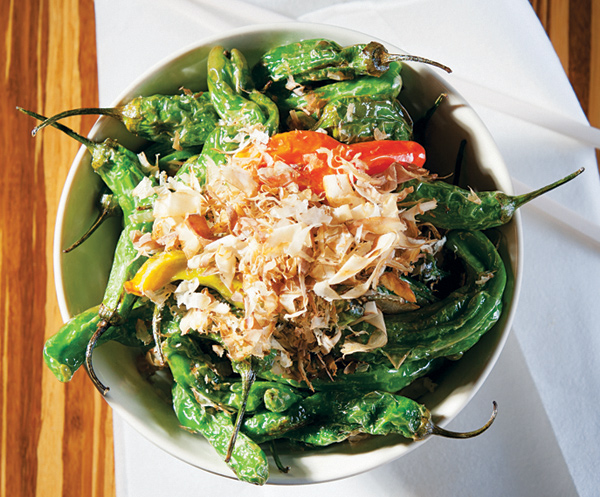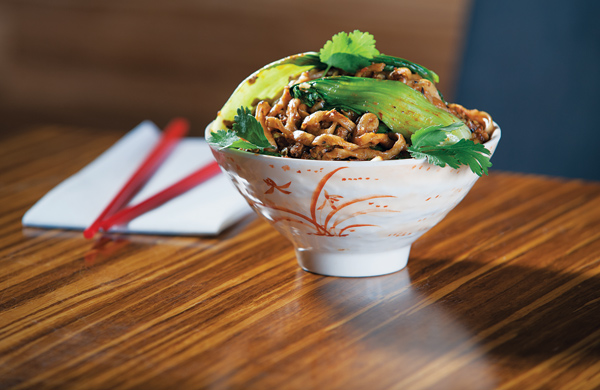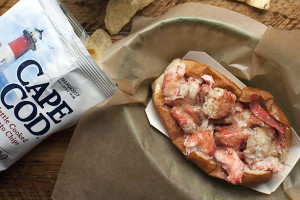Restaurant Review: Moksa
Variety is the spice of life — except when it makes for an inconsistent dining experience.

Dancing shishito peppers. (Photo by Angela Coppola)
The new Moksa is in the heart of Central Square, but Patricia Yeo makes vibrant, varied dishes that fill you with the excitement of eating at a street stall in, say, Singapore or Penang. The flavors are bright, kaleidoscopic, and surprising. The sensations range from unexpected blasts of pepper-born spice to the comforting texture of soft, fresh noodles and dumplings. There’s heat, sweet, salt — something for everyone. With its reasonable prices and casual, friendly service, Moksa is aiming for a young crowd, including those who frequent the club space — called Naga — in the rear of the restaurant. There’s a busy bar at the front and pleasant outdoor seating on the side, which, despite the Mass. Ave. noise, is likely to be quieter than the main dining room.
The problem is that with 180 seats — far more than the number at Yeo’s previous restaurant, Ginger Park — and a much larger kitchen staff to supervise, the results are uneven. Very uneven. I didn’t know from one dinner to the next whether duck confit shao bing ($6), a flatbread from northern China that looks like a pressed English muffin, would be tender, slightly rich, crisped along the griddle marks, and filled with melting shreds of spiced duck leg — or stale, under-toasted, and stuffed with dry strings of flavorless meat. During one meal, the ramen with pork belly and half a soft-boiled egg ($14) featured subtly seasoned broth and pleasantly chewy, squiggly noodles. Another time, though, it was just an odd, sourish liquid with clumped-together noodles that resembled a rubber-band softball. One night, edamame pot stickers ($6, no longer on the menu) were a why-didn’t-anyone-think-of-that combination of puréed beans and lots of mint — like a greener, fresher, better-flavored version of spinach ravioli. The next, they were chewy, raw, and gritty. Yeo, an inventive cook when it comes to merging the Asian flavors she knows and loves from her travels and her upbringing in Malaysia, set out to do a bit too much in a big new restaurant with a big staff and a too-big menu.

The sleek, modern dining room at Moksa. (Photo by Angela Coppola)
When Yeo first made her name at New York’s AZ, the fusion of Western kitchen techniques with Asian ingredients and flavors was new. Now it isn’t. By the time Yeo came to Boston to relaunch the French-Asian eatery Banq as Ginger Park, Joanne Chang had already opened her homey Chinese restaurant Myers + Chang around the corner, while Tim Cushman had followed Ken Oringer’s example at Uni by reinventing fusion sushi with house-made sauces and seasonings for his fine-dining spot, O Ya. The strength of Yeo’s dan dan noodles, with their umami-packed Szechuan pork-and-mushroom ragu, helped Ginger Park stand out until it closed in 2010.
More recently, young chefs have started to overlay the latest food fashions onto fusion cuisine. Echoes of the gutsy fare available at David Chang’s New York eatery Momofuku Ssäm Bar can be heard in, of all places, Watertown, where Strip–T’s chef (and Momofuku grad) Tim Maslow has introduced Asian touches (like Japanese eggplant banh mi) as part of a total overhaul of his father’s menu. At East by Northeast in Inman Square, Phillip Tang is adding a local-seasonal element to his Chinese background and French-cuisine training, showcasing a new kind of Asian-influenced, immaculately plated fare.

Roti with popcorn shrimp and black-bean-and-mango salsa. (Photo by Angela Coppola)
The bar, then, has been set a lot higher. But Yeo can still lay claim to the territory she originally staked out. She roams freer across Asia than any of those chefs, and tries for a much broader range of street food: dumplings, buns, yakitori-style grilled and skewered bits of meat, noodles, fried rice. And there’s so much to be deeply satisfied by: Twice-cooked green beans ($6) were oily, soft, and flavorful thanks to salted soy beans, garlic, and chili flakes. Irresistible “dancing” shishito peppers ($6) — named for the topping of paper-thin, smoky-flavored bonito flakes that wave at you as they wilt — were flash-fried so the whole peppers were almost luminous, and a green-mango-and-papaya salad with peanuts ($7) was freshened with basil, mint, and cilantro in a sweet-savory caramel-lemongrass dressing.
It’s hard to do everything well, though, especially when you’re up against a host of casual restaurants that specialize in dishes you have on the menu, like, for example, pho ($11), which here was bland, monotone, and surprisingly lacking in salt — or chow fun, broad rice noodles ($14) that should be caramelized from stir-frying but instead were just grease-slicked and pale. Every component of fried rice is supposed to be lightly crisped, but in each version we tried, like the gelatinous oxtail and tongue ($14), the dish was drenched in oil.

Dan dan mein with spicy pork-mushroom ragu. (Photo by Angela Coppola)
Better, then, to concentrate on the unusual and original, like the rotis, the tortillalike Indian flatbreads Yeo knows from her Malaysian childhood. They’re served as open-faced sandwiches with several toppings; the best were popcorn shrimp fried in cayenne-spiked cornmeal breading and topped with mango-and-black-bean salsa ($7), and little squares of blackened white fish with a charred-tomato-and-tomatillo salsa ($8).
The menu also features a variety of northern Chinese noodles. The broad “hand-ripped” kind, which have toasted nori and bonito flakes in the dough, are stir-fried with oven-dried cherry tomatoes, cucumber, and shredded beef shin ($12) — an economical off cut that added terrific flavor. “Uyigur-style” lamb with oval coins of rice gnocchi ($15) made for a striking dish, thanks to lamb chunks marinated in spices of the Silk Road (the Uighurs are a Muslim people living in the far west of China) and fresh peppers, bok choy, and broccolini. The dish was a knockout, and not just because of the heat.

Green-mango-and-papaya salad with peanuts. (Photo by Angela Coppola)
I was glad to hear Yeo say she has plans to scale her ambitions both up and back. The scaling back has already started, where it most counts: cutting about 10 dishes that weren’t selling strongly. The scaling up is adding a restaurant within a restaurant: a counter at the back, projected to open this month, that will offer omakase-style multicourse tasting menus. It will give Yeo, her chef friends, and her staff a way to get more seasonality — and even more variety — onto the menu.
Variety! There’s plenty of that at Moksa already, probably too much. But with more consistency, Moksa will be an exciting, affordable place to order something you haven’t had before, and will want to try again.
Moska, 450 Massachusetts Ave., Cambridge, 617-661-4900, moksarestaurant.com.
Critic Corby Kummer — an editor at The Atlantic and author of The Pleasures of Slow Food — has been reviewing Greater Boston’s top restaurants in Boston magazine since 1997.

